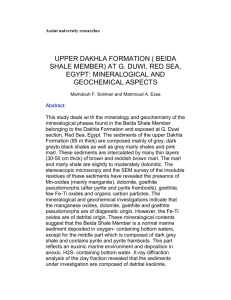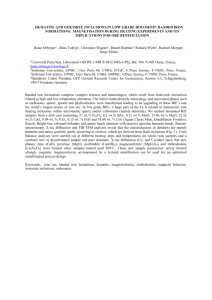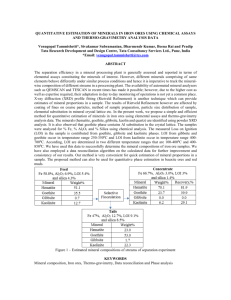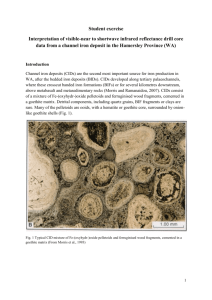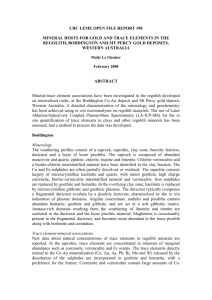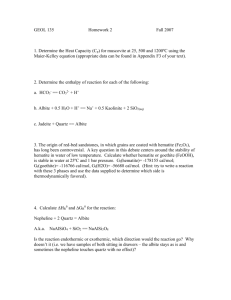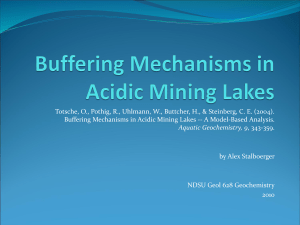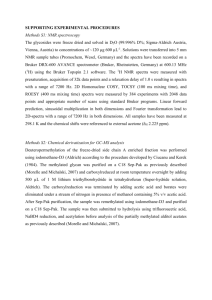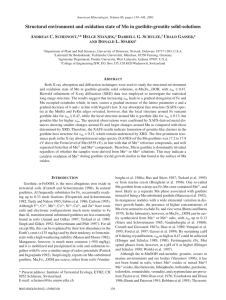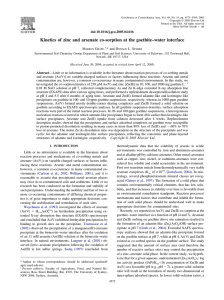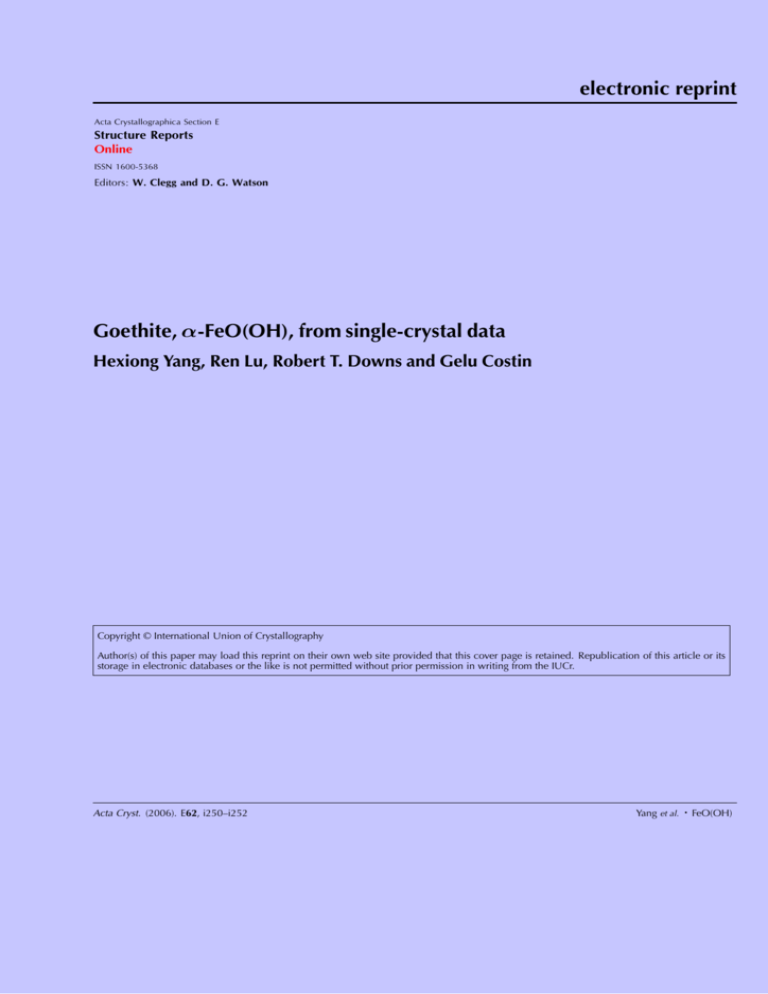
electronic reprint
Acta Crystallographica Section E
Structure Reports
Online
ISSN 1600-5368
Editors: W. Clegg and D. G. Watson
Goethite, «-FeO(OH), from single-crystal data
Hexiong Yang, Ren Lu, Robert T. Downs and Gelu Costin
Copyright © International Union of Crystallography
Author(s) of this paper may load this reprint on their own web site provided that this cover page is retained. Republication of this article or its
storage in electronic databases or the like is not permitted without prior permission in writing from the IUCr.
Acta Cryst. (2006). E62, i250–i252
Yang et al.
¯
FeO(OH)
inorganic papers
Acta Crystallographica Section E
Structure Reports
Online
Goethite, a-FeO(OH), from single-crystal data
ISSN 1600-5368
Hexiong Yang,* Ren Lu,
Robert T. Downs and Gelu
Costin
University of Arizona, Department of
Geosciences, 1040 East 4th Street, Tucson,
AZ 85721-0077, USA
Correspondence e-mail: hyang@u.arizona.edu
Key indicators
Single-crystal X-ray study
T = 273 K
Mean (e–O) = 0.001 Å
R factor = 0.019
wR factor = 0.052
Data-to-parameter ratio = 21.0
This is the first reported structure refinement of goethite, FeO(OH), on the basis of a single-crystal X-ray diffraction
study. The structure of goethite, isostructural with diaspore,
AlO(OH), and groutite, MnO(OH), can be described in terms
of a slightly distorted hexagonal close-packed O-atom
arrangement with Fe atoms occupying one-half of the
octahedral interstices, and with all atoms located on mirror
planes. There are two distinct O sites, O1 and O2, each bonded
to three Fe atoms, with O2 additionally bonded to an H atom.
The O2—H O1 donor–acceptor distance in goethite is
significantly longer than that in diaspore or groutite, indicating
that the hydrogen bonding in goethite is the weakest of the
three minerals. Analysis of refinement data for the three
isostructural compounds reveals rigid-body thermal motion
behavior of the octahedral groups.
Received 11 October 2006
Accepted 8 November 2006
Comment
For details of how these key indicators were
automatically derived from the article, see
http://journals.iucr.org/e.
# 2006 International Union of Crystallography
All rights reserved
i250
Yang et al.
FeO(OH)
Goethite, -FeO(OH), is one of the most widespread forms of
iron oxides in terrestrial soils, sediments and ore deposits
(Cornell & Schwertmann, 2003; Strucki et al. 1988), as well as a
common weathering product in rocks of all types (Ozdemir &
Dunlop, 2000). It transforms to hematite (-Fe2O3) between
453 and 543 K through dehydrogenation and has been used
extensively in the preparation of maghemite (-Fe2O3) in
magnetic storage media. The crystal structure of goethite was
first determined by Goldsztaub (1935) and Hoppe (1940)
using X-ray diffraction photographic techniques. Forsyth et al.
(1968) and Szytula et al. (1968) examined the magnetic
structure of goethite with neutron powder diffraction on both
natural and synthetic samples and found that it is anti-ferromagnetic below about 373 K (the Néel point). The structural
behavior of goethite as a function of temperature and pressure
was investigated by Gualtieri & Venturelli (1999) and Nagai et
al. (2003), respectively, by means of synchrotron X-ray powder
diffraction. However, despite both its mineralogical and
technological interest, no detailed structural information, such
as anisotropic atomic displacement parameters, are available
for goethite because of the lack of a single-crystal X-ray
diffraction structure analysis.
Goethite is isostructural with diaspore, AlO(OH), and
groutite, MnO(OH) (Forsyth et al., 1968; Szytula et al., 1968).
Its structure can be described in terms of a slightly distorted
hexagonal close-packed O-atom arrangement with Fe atoms
occupying one-half of the octahedral interstices. The Fe3+O6
octahedra share edges to form double chains running parallel
to c, which are further linked to form a three-dimensional
structure by sharing vertices (Fig. 1). There are two distinct O
sites, O1 and O2, both coordinated to three Fe atoms, with O2
additionally bonded to an H atom. In spite of the same ionic
doi:10.1107/S1600536806047258
electronic reprint
Acta Cryst. (2006). E62, i250–i252
inorganic papers
radius of 0.645 Å for six-coordinated Fe3+ and Mn3+ ions
(Shannon, 1976), the average M3+—O bond length within the
Fe3+O6 octahedron in goethite (2.026 Å) is slightly shorter
than that within the Mn3+O6 octahedron in groutite (2.039 Å),
due to the obvious Jahn–Teller effect of Mn3+.
A translational–librational–screw (TLS) rigid-body analysis
(Schomaker & Trueblood, 1968; Downs, 2000) was conducted
on the FeO6, AlO6 and MnO6 octahedral groups in goethite,
diaspore (Hill, 1979) and groutite (Kohler et al., 1997),
respectively. The atomic displacement parameters reveal rigidbody behavior with differences in the mean-square displacement amplitudes along the M—O bonds of less than 0.001 Å2.
The librational angles are small, at 1.7, 1.3 and 1.5 for
goethite, diaspore and groutite, respectively. These magnitudes result in a very small thermal effect on the bond lengths.
They are consistent with high-quality diffraction data, and
with the edge-sharing topology of the double octahedral
chains.
Hydrogen bonding is found between atom O2 of one FeO6
octahedron and an O1 atom in an adjacent one, with an O2—
H distance of 0.88 Å and an O2—H O1i angle of 161 (3) .
This value is comparable with that in diaspore [160.8 (1) ; Hill,
1979] but notably smaller than that in groutite [171 (4) ;
Kohler et al., 1997]. The non-linear hydrogen bonding in
goethite is known to be of moderate strength and represents
the most common type of hydrogen bond (Jeffrey, 1997).
Nevertheless, the donor–acceptor O2—H O1i distance in
goethite [2.747 (1) Å] is significantly longer than those in
diaspore [2.649 (1) Å; Hill, 1979] or groutite [2.619 (1) Å;
Kohler et al., 1997], indicating that the hydrogen bonding in
goethite is the weakest of the three minerals. This observation
is consistent with the IR spectroscopic measurements; the OH
stretching bands decrease from 3100 cm1 in goethite to
2950 cm1 in diaspore (Libowitzky & Rossman, 1997) and to
2685 cm1 in groutite (Kohler et al., 1997).
Experimental
The goethite crystal used in this study is a natural sample from Park
County, Colorado, USA (RRUFF project collection, R050142; http://
rruff.info). Within experimental uncertainty, the chemical composition determined with an electron microprobe is that of ideal
FeO(OH).
Z=4
Dx = 4.275 Mg m3
Mo K radiation
= 10.30 mm1
T = 273 (2) K
Block, brown
0.09 0.09 0.08 mm
Data collection
Bruker SMART APEX2 CCD areadetector diffractometer
’ and ! scans
Absorption correction: multi-scan
(SADABS; Sheldrick, 2005)
Tmin = 0.410, Tmax = 0.441
Acta Cryst. (2006). E62, i250–i252
The crystal structure of goethite, -FeO(OH). O atoms are drawn with
anisotropic displacement ellipsoids at the 90% probability level and H
atoms with arbitrary radii. Hydrogen bonding is indicated with green
lines.
Refinement
Refinement on F 2
R[F 2 > 2(F 2)] = 0.019
wR(F 2) = 0.052
S = 1.15
483 reflections
23 parameters
All H-atom parameters refined
w = 1/[ 2(Fo2) + (0.034P)2]
where P = (Fo2 + 2Fc2)/3
(/)max = 0.001
max = 0.98 e Å3
min = 1.00 e Å3
Extinction correction: SHELXL97
(Sheldrick, 1997)
Extinction coefficient: 0.087 (9)
Table 1
Selected bond lengths (Å).
Fe—O1i
Fe—O1ii
1.9325 (9)
1.9560 (6)
Fe—O2iii
Fe—O2iv
2.0996 (9)
2.1063 (7)
Symmetry codes: (i) x þ 12; y þ 12; z; (ii) x þ 1; y þ 1; z þ 1; (iii) x; y þ 1; z; (iv)
x; y þ 1; z.
Consistent with previous studies, the non-standard setting Pbnm of
space group Pnma was used. The H atom was located in a difference
Fourier map and its position was refined freely.
Data collection: SMART (Bruker, 2003); cell refinement: SAINT
(Bruker, 2005); data reduction: SAINT; program(s) used to solve
structure: SHELXS97 (Sheldrick, 1997); program(s) used to refine
structure: SHELXL97 (Sheldrick, 1997); molecular graphics: XtalDraw (Downs & Hall-Wallace, 2003); software used to prepare
material for publication: SHELXTL (Bruker, 1997).
The authors thank Dave Bunk Minerals for the donation of
the sample.
Crystal data
FeO(OH)
Mr = 88.86
Orthorhombic, Pbnm
a = 4.5979 (2) Å
b = 9.9510 (5) Å
c = 3.0178 (1) Å
V = 138.08 (1) Å3
Figure 1
2197 measured reflections
483 independent reflections
458 reflections with I > 2(I)
Rint = 0.017
max = 40.5
References
Bruker (1997). SHELXTL. Version 5.10. Bruker AXS Inc., Madison,
Wisconsin, USA.
Bruker (2003). SMART. Version 6.0. Bruker AXS Inc., Madison, Wisconsin,
USA.
Bruker (2005). SAINT. Version 6.0. Bruker AXS Inc., Madison, Wisconsin,
USA.
Cornell, R. M. & Schwertmann, U. (2003). The Iron Oxides, pp. 2–10.
Weinheim: VCH Verlag.
Downs, R. T. (2000). Rev. Mineral. Geochem. 41, 61–87.
Downs, R. T. & Hall-Wallace, M. (2003). Am. Mineral. 88, 247–250.
Forsyth, J. B., Hedley, I. G. & Johnson, C. E. (1968). J. Phys. C, 1, 179–188.
Goldsztaub, M. S. (1935). Bull. Soc. Fr. Mineral. 58, 6–67.
Gualtieri, A. F. & Venturelli, P. (1999). Am. Mineral. 84, 895–904.
electronic reprint
Yang et al.
FeO(OH)
i251
inorganic papers
Hill, R. J. (1979). Phys. Chem. Miner. 5, 179–200.
Hoppe, V. W. (1940). Z. Kristallogr. 103, 73–89.
Jeffrey, G. A. (1997). An Introduction to Hydrogen Bonding, pp. 56–78. New
York: Oxford University Press.
Kohler, T., Armbruster, T. & Libowitzky, E. (1997). J. Solid State Chem. 133,
486–500.
Libowitzky, E. & Rossman, G. R. (1997). Am. Mineral. 82, 1111–1115.
Nagai, T., Kagi, H. & Yamanaka, T. (2003). Am. Mineral. 88, 1423–1427.
Ozdemir, O. & Dunlop, D. J. (2000). Earth Planet. Sci. Lett. 177, 59–67.
Schomaker, V. & Trueblood, K. N. (1968). Acta Cryst. B24, 63–76.
i252
Yang et al.
FeO(OH)
Shannon, R. D. (1976). Acta Cryst. A32, 751–767.
Sheldrick, G. M. (1997). SHELXS97 and SHELXL97. University of
Göttingen, Germany.
Sheldrick, G. M. (2005). SADABS. Version 2.10. University of Göttingen,
Germany.
Strucki, J. W., Goodman, B. A. & Schwertmann, U. (1988). Iron in Soils and
Clay Minerals. NATO ASI Series C217. Boston: Reidel Publishing
Company.
Szytula, A., Burewicz, A., Dimitrijevic, Z., Krasnicki, S., Rzany, H., Todorovic,
J., Wanic, A. & Wolski, W. (1968). Phys. Status Solidi, 26, 429–434.
electronic reprint
Acta Cryst. (2006). E62, i250–i252

